Strumigenys glycon
| Strumigenys glycon | |
|---|---|

| |
| Scientific classification | |
| Kingdom: | Animalia |
| Phylum: | Arthropoda |
| Class: | Insecta |
| Order: | Hymenoptera |
| Family: | Formicidae |
| Subfamily: | Myrmicinae |
| Tribe: | Attini |
| Genus: | Strumigenys |
| Species: | S. glycon |
| Binomial name | |
| Strumigenys glycon Fisher, 2000 | |
Known from litter samples, and a single collection from a rotten log, in various forest habitats.
Identification
Bolton (2000) - A member of the scotti complex in the Strumigenys scotti-group. S. glycon is distinguished from other species in the scotti-complex by having the mesonotum with only a single pair of erect hairs located at anterior margin, dorsum of petiole node reticulate-punctate, spongiform curtain of petiolar peduncle well developed, and cephalic dorsum with inconspicuous narrow filiform ground-pilosity.
S. glycon is part of closely related group of the eight smallest species in the scotti-complex with the dorsum of petiole node reticulate-punctate (all or at least some specimens of each species with HL > 0.54). The following matrix summarizes the key characters that help separate the members of this group. See discussion under Strumigenys lexex for characters that distinguish it from Strumigenys livens.
Character 1: number of pairs of hairs on mesonotum . Character 2: number o f pairs o f hairs o n pronotum, excluding the flagellate humeral hairs. Character 3: Depth of spongiform curtain on ventral surface of petiolar peduncle.
| 1 | 2 | 3 | |
| Strumigenys glycon | 1 | 0 or 1 | deep |
| Strumigenys inatos | 1 | 0 | narrow |
| Strumigenys livens | 2 | 0 | narrow |
| Strumigenys odacon | 2 | 0 | deep |
| Strumigenys lura | 2 or 3 | 2 | narrow |
| Strumigenys lexex | 2 or 3 | 0 | narrow |
| Strumigenys lucomo | 3 | 2 | narrow |
| Strumigenys origo | 3 | 1 | deep |
Keys including this Species
Distribution
Latitudinal Distribution Pattern
Latitudinal Range: -13.998° to -15.56667°.
| North Temperate |
North Subtropical |
Tropical | South Subtropical |
South Temperate |
- Source: AntMaps
Distribution based on Regional Taxon Lists
Malagasy Region: Madagascar (type locality).
Distribution based on AntMaps
Distribution based on AntWeb specimens
Check data from AntWeb
Countries Occupied
| Number of countries occupied by this species based on AntWiki Regional Taxon Lists. In general, fewer countries occupied indicates a narrower range, while more countries indicates a more widespread species. |

|
Estimated Abundance
| Relative abundance based on number of AntMaps records per species (this species within the purple bar). Fewer records (to the left) indicates a less abundant/encountered species while more records (to the right) indicates more abundant/encountered species. |

|
Biology
Castes
Worker
Images from AntWeb
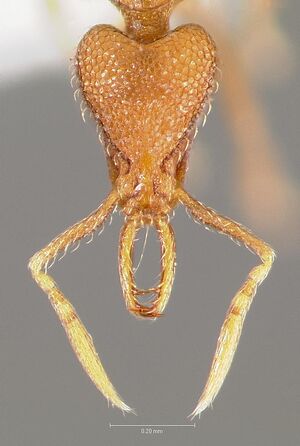 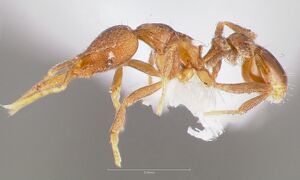  
| |
| Paratype of Strumigenys glycon. Worker. Specimen code casent0005543. Photographer April Nobile, uploaded by California Academy of Sciences. | Owned by CAS, San Francisco, CA, USA. |
  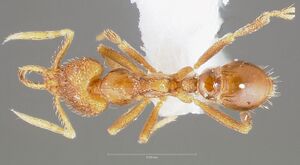 
| |
| Holotype of Strumigenys glycon. Worker. Specimen code casent0005544. Photographer April Nobile, uploaded by California Academy of Sciences. | Owned by MCZ, Cambridge, MA, USA. |
Queen
Images from AntWeb
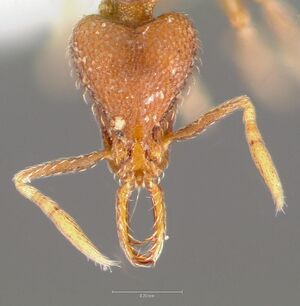  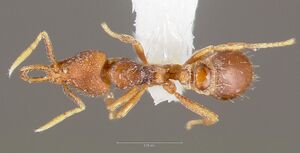 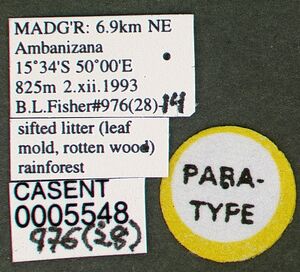
| |
| Paratype of Strumigenys glycon. Queen (alate/dealate). Specimen code casent0005548. Photographer April Nobile, uploaded by California Academy of Sciences. | Owned by CAS, San Francisco, CA, USA. |
Nomenclature
The following information is derived from Barry Bolton's Online Catalogue of the Ants of the World.
- glycon. Strumigenys glycon Fisher, in Bolton, 2000: 682 (w.q.) MADAGASCAR.
Unless otherwise noted the text for the remainder of this section is reported from the publication that includes the original description.
Description
Worker
Holotype. TL 1.9, HL 0.45, HW 0.34, CI 75, ML 0.22, MI 48, SL 0.28, SI 83, PW 0.23, AL 0.48. Characters of scotti-complex. Mandibles in full-face view evenly bowed outwards, the width approximately constant from the level of the proximal preapical tooth to near the base. Upper scrobe margin evenly and shallowly convex in full-face view, not bordered by a rim or flange except immediately behind the frontal lobes, the eyes visible, the apices of the upper scrobe margins confluent with the sides of the occipital lobes through an even curve, without an angle separating the two. Eye small, maximum diameter slightly less than maximum width of scape, with 3-4 ommatidia in longest row. Scape narrow and subcylindrical, curved near the base, leading edge slightly expanded behind curve; hairs on leading edge filiform to narrowly spatulate. Cephalic dorsum clothed with inconspicuous narrow filiform ground-pilosity, the upper scrobe margin fringed with hairs which are similar in shape and size as those on the leading edge of the scape. Cephalic dorsum with 6 standing narrow filiform hairs arranged in a transverse row of 4 close to the occipital margin and a more anteriorly situated pair. Pronotal humeral hair fine and flagellate; central pronotum with a pair of fine, short hairs that are curved towards the midline; humeral angles rounded, lateral margin of posterior pronotum bluntly marginate. Anterior margin of mesonotum with a pair of standing filiform hairs that are thickened apically, lateral margins of mesonotum posterior of the standing hairs with shorter decumbent hairs that curve toward the midline. Propodeum with one pair of short, fine, posteriorly curved hairs immediately anterior of propodeal spines. Dorsal alitrunk with sparse inconspicuous fine appressed ground-pilosity. Dorsum of alitrunk in outline convex anteriorly and posteriorly gently sloping to the declivity. Anterior mesonotum with a thin carina above the mesothoracic spiracle; mesopleural gland set in a small circular notch. Propodeal tooth small, triangular, lamellate, pointed apically, and subtended by an inconspicuous very narrow lamella. Pronotal dorsum and sides longitudinally striolate with a longitudinal carina along dorsal midline. Mesonotal dorsum rugose with punctulate sculpture. Propodeal dorsum shiny and superficially areolate. Pleurae and sides of propodeum glassy smooth except for punctures along the vertical groove above mesopleural gland. Postpetiole disc smooth and shiny. Spongiform appendages of pedicel segments greatly expanded; in profile ventral spongiform curtain of petiolar peduncle well developed, its deepest point at least equal to height of base of peduncle. Basigastral costulae sharply defined, radiating on each side of a broad central clear area. Dorsal surface of petiole, postpetiole and gaster with standing filiform hairs. Colour light brown.
Paratypes. TL 1.9-2.0, HL 0.42-0.46, HW 0.34-0.35, CI 74-80, ML 0.22-0.23, MI 48-55, SL 0.27-0.29, SI 77-83, PW 0.21-0.22, AL 0.47-0.49. (4 measured). As holotype.
Measurements of this material extend the range shown by the type-series: HL 0.45-0.48, HW 0.35-0.38, CI 77-82, ML 0.24, MI 49-53, SL 0.27-0.33, SI 78-86 (4 measured). Specimens from R. S. Manongarivo lack a pair of fine, short hairs that are curved towards the midline on the central pronotum.
Type Material
Holotype worker, Madagascar: 6.9 km. NE Ambanizana, 15°34'S, 50°00'E, 825 m., 2.xii.1993, sifted litter (leaf mold, rotten wood), rainforest, #976 (48)-16 (B. L. Fisher) (Museum of Comparative Zoology).
Paratypes. 4 workers and 1 ergatogyne with same data as holotype but coded (15)-12, (28)-14, (45)-14, (46)-15, (49)-13 (The Natural History Museum, South African Museum).
References
- Fisher, B.L. 2000. The Malagasy fauna of Strumigenys. Pp. 612-696 in: Bolton, B. 2000. The ant tribe Dacetini. Memoirs of the American Entomological Institute. 65:1-1028. (page 682, worker described)
References based on Global Ant Biodiversity Informatics
- Bolton, B. 2000. The Ant Tribe Dacetini. Memoirs of the American Entomological Institute 65
- Fisher B. L. 2003. Formicidae, ants. Pp. 811-819 in: Goodman, S. M.; Benstead, J. P. (eds.) 2003. The natural history of Madagascar. Chicago: University of Chicago Press, xxi + 1709 pp.
- Fisher, B. 2002. Ant diversity patterns along an elevational gradient in the Reserve Speciale de Manongarivo, Madagascar. in Gautier, L. and S.M. Goodman, editors, Inventaire Florestique et Faunistique de la Reserve Speciale de Manongarivo (NW Madagascar)

